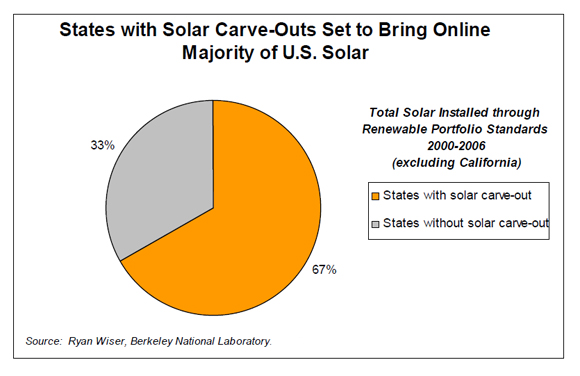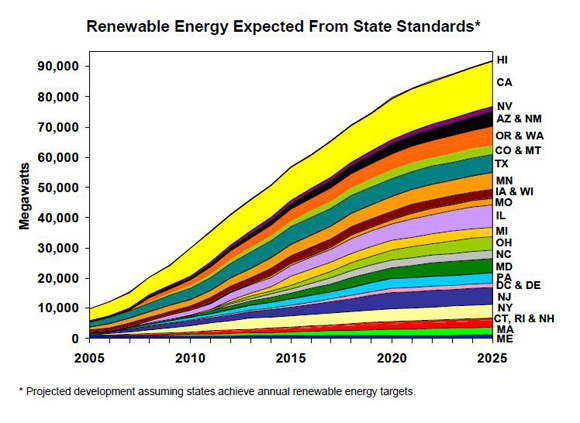UPDATE: Read updated version “Arizona Set to Abandon Leadership on Solar Power. Big Winner: China” in OnEarth magazine
Snatching defeat from the jaws of victory
Just seven months after Arizona enacted a law that supporters said would help make the state the “solar capital” of the nation, new legislation has been introduced that opponents maintain could kill the nascent industry.
House bill 2701 “would surely be the death knell for advancing solar energy in the state,” Kris Mayes, chair of the Arizona Corporation Commission, told the Phoenix Business Journal on Friday.
The bill would define “renewable” to include nuclear power (despite the fact that nuclear plants need to be refueled periodically). That change would end what many experts consider the most effective incentive for installing solar and wind generation: the Renewable Energy Standard (RES).
Under current law, the Arizona Corporation Commission’s RES mandates that utilities must generate 15 percent of electricity from renewable sources by the year 2025. Since the state’s largest utility, APS, already gets approximately 27 percent of its electricity from a nuclear power plant outside of Phoenix, HB 2701 would allow the company to stop adding any new renewable power sources.
Sean Seitz, president of American Solar Electric, one of the largest solar installers in the valley, agreed with Mayes’ assessment of HB 2701. “If this bill passed in its current form,” predicted Seitz, “the current program…would be a skeleton of itself.”
The bill would make Arizona the only state that includes existing nuclear power plants in an RES.
Sponsors say that solar projects would continue even without the RES. A 2007 study from the Berkeley National Laboratory, however, appears to contradict that claim.
The report compared actual solar installations made between 2000 and 2006 in states with and without an RES supporting solar (California was excluded from the study because of its other progressive solar policies).
The difference is clear in the chart below. States with an RES had more than double the solar installations of states lacking such a mandate. (Currently, 32 states and Washington DC have some form of RES.)
RES Boosts Arizona Jobs, Technology Innovation
In 2001, Arizona was one of the first states to adopt an RES. The policy has taken new solar technologies from the drawing board to reality and attracted jobs in solar manufacturing, installation and R&D.
The Saguaro Solar Generating Station
On Earth Day, 2006, APS dedicated the first solar trough system built in the US since 1990. The 1-MW Sagauro station uses giant mirrors to concentrate sunlight on a tube filled with mineral oil. That oil boils an organic liquid, which turns turbine to produce electricity. The Saguaro facility uses six rows of 15-foot-tall mirrors.
According to an APS spokesman, Arizona’s RES “was a major catalyst for the for the solar trough project. We realized that we needed something on a large scale if we were going to meet the goals.”
The maker of the solar receivers used at Saguaro underscored the important role the RES played in developing the solar thermal station.
“The Saguaro Power plant is a significant step forward for Arizona as it seeks to reach its goal of generating 15 percent of its electricity from renewable resources within the next 20 years,” said Udo Ungeheuer, chairman of the Schott Management Board.
The Department of Energy’s Western Area Power Administration called the Saguaro project “the solar comeback story of the year.”
Now, by removing the RES incentive, HB 2107 could be Arizona’s solar fall-behind story of the year. A look at the reasons behind a recent Arizona industry victory shows why.
In November, 2009, Chinese solar manufacturing giant, Suntech Power, announced plans to build the company’s first North American plant in Arizona, with production to begin later this year. In a press release, the largest manufacturer of solar panels in China said it “selected the Greater Phoenix area for its plant because of Arizona’s leadership in research through Arizona State University, and statewide renewable energy policies, particularly its Renewable Energy Standard…”
Arizona Jobs and Renewable Energy Growth
Nationally, several studies have shown the potential for job growth through expanding renewable energy — providing cleaner air, fighting climate change and expanding employment at the same time. Last year, a study by the Union of Concerned Scientists examined the link between states with strong RES requirements and the growth of renewable power (and, so, jobs).
The study found that if states achieve their RES targets, 76,759 MW of new renewable power capacity will be in place by 2025 — enough electricity to power 47 million homes. HB 2701 would remove Arizona from this pattern of growth.
Fast-tracked
Despite the considerations above, the bill appears likely to pass in both the Arizona House and Senate. HB 2701 has 52 sponsors and co-sponsors, including Senate President Robert Burns and Speaker of the House Kirk Adams. (Both are primary sponsors of the bill.)
HB 2701 will almost certainly sail through the two committees to which it’s been assigned: Government and Rules.
The House Government Committee is chaired by Representative Judy Burges (R), one of the bill’s sponsors. Five of the remaining eight members are also Republicans — and also sponsors of HB 2701. None of the Democrats on the committee are sponsors, but there are only three of them.
The committee will take up HB 2701 this Tuesday, February 23, at 2:00 PM Mountain Time.
Next it moves to the House Rules committee where the track appears to be just as fast:
The chairman is Rep. Warde Nichols (R), a sponsor of the bill. The House Speaker, Kirk Adams, a sponsor, sits on the eight-member committee. That leaves six members — three are Republicans (and sponsors). One of the three Democrats, Rep. Jack Brown, is a co-sponsor of HB 2701, leaving only two non-sponsors on the committee.
Check back for updates; The Phoenix Sun will continue to cover HB 2701.






 In the developing world, El Gammal sees an even larger role for solar PV.
In the developing world, El Gammal sees an even larger role for solar PV.